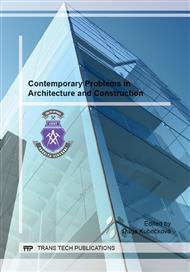[1]
R. Cajka, J. Labudkova, Influence of parameters of a 3D numerical model on deformation arising in interaction of a foundation structure and subsoil. 1st International Conference on High-Performance Concrete Structures and Materials (COSTMA '13). Budapest, Hungary, December 10-12, 2013, ISSN 2227-4359, ISBN 978-960-474-352-0.
Google Scholar
[2]
R. Cajka, J. Labudkova, Dependence of deformation of a plate on the subsoil in relation to the parameters of the 3D model. International Journal of Mechanics, 2014 (in print).
Google Scholar
[3]
R. Cajka, V. Krivy, D. Sekanina, Design and Development of a Testing Device for Experimental Measurements of Foundation Slabs on the Subsoil. Transactions of the VSB - Technical University of Ostrava, Civil Engineering Series, Volume XI, Number 1/2011, Issue 1, Pages 1–5, ISSN (Online) 1804-4824, ISSN (Print) 1213-1962. DOI: 10. 2478/v10160-011-0002-2, June (2011).
DOI: 10.2478/v10160-011-0002-2
Google Scholar
[4]
R. Cajka, K. Burkovic, R. Fojtik, V. Buchta, Experimental Soil – Concrete Plate Interaction Test and Numerical Models. Key Engineering Materials, Vols. 577-578, (2014), pp.33-36, doi: 10. 4028/www. scientific. net/KEM. 577-578. 33.
DOI: 10.4028/www.scientific.net/kem.577-578.33
Google Scholar
[5]
R. Cajka, R. Fojtik, Development of Temperature and Stress during Foundation Slab Concreting of National Supercomputer Centre IT4, Procedia Engineering, Volume 65, 2013, Pages 230-235, ISSN 1877-7058, doi: 10. 1016/j. proeng. 2013. 09. 035.
DOI: 10.1016/j.proeng.2013.09.035
Google Scholar
[6]
R. Cajka, K. Burkovic, V. Buchta, Foundation slab in interaction with subsoil. Advanced Materials Research. Volume 838-841, 2014, Pages 375-380, ISSN: 10226680 ISBN: 978-303785926-1, DOI: 10. 4028/www. scientific. net/AMR. 838-841. 375.
DOI: 10.4028/www.scientific.net/amr.838-841.375
Google Scholar
[7]
R. Cajka, P. Mateckova, M. Janulikova, Bitumen Sliding Joints for Friction Elimination in Footing Bottom. Applied Mechanics and Materials, Volume 188, (2012).
DOI: 10.4028/www.scientific.net/amm.188.247
Google Scholar
[8]
R. Cajka, P. Manasek, Building Structures in Danger of Flooding. IABSE Conference New Delhi, India 2005: Role of Structural Engineers towards Reduction of Poverty. New Delhi, India, pp.551-558 ISBN 978-3-85748-111-6, WOS: 000245746100072, (2005).
DOI: 10.2749/222137805796272296
Google Scholar
[9]
R. Cajka, P. Labudek, K. Burkovic, M. Cajka, Golf Club Structure and Foundation with Slide Joint on the Undermined Territory. 6th WSEAS International Conference on Engineering Mechanics, Structures, Engineering Geology (EMESEG '13), WSEAS / NAUN International Conferences, Cambridge, UK, February 20-22, 2013, ISSN 2227-4588, ISBN 978-1-61804-165-4.
Google Scholar
[10]
R. Cajka, Determination of Friction Parameters for Soil – Structure Interaction Tasks. Recent Researches in Environmental & Geological Sciences. Energy, Environmental and Structural Engineering Series No. 4, pp.435-440.
Google Scholar
[11]
R. Cajka, General Contact Element using Jacobian of Transformation and Gauss Numerical Integration of Half-space. In Proceedings of the 3rd International Conference on Mathematical Models for Engineering Science (MMES´12), WSEAS Press, Paris, France, December 2-4, 2012, pp.23-28.
Google Scholar
[12]
R. Cajka, Accuracy of Stress Analysis Using Numerical Integration of Elastic Half-Space (2013), Applied Mechanics and Materials, 300-301, pp.1127-1135. ISSN: 16609336, ISBN: 978-303785651-2, DOI: 10. 4028/www. scientific. net/AMM. 300-301. 1127.
DOI: 10.4028/www.scientific.net/amm.300-301.1127
Google Scholar
[13]
R. Cajka, Horizontal Friction Parameters in Soil – Structure Interaction Tasks. Advanced Materials Research, Vol. 818 (2013), pp.197-205, Trans Tech Publications, Switzerland, doi: 10. 4028/www. scientific. net/AMR. 818. 197.
DOI: 10.4028/www.scientific.net/amr.818.197
Google Scholar
[14]
R. Cajka, Analysis of Stress in Half-space using Jacobian of Transformation and Gauss Numerical Integration. Advanced Materials Research, Vol. 818 (2013).
DOI: 10.4028/www.scientific.net/amr.818.178
Google Scholar
[15]
R. Cajka, Comparison of the calculated and experimentally measured values of settlement and stress state of concrete slab on subsoil. Applied Mechanics and Materials. Volume 501-504, 2014, Pages 867-876, ISSN: 16609336 ISBN: 978-303835005-7, DOI: 10. 4028/www. scientific. net/AMM. 501-504. 867.
DOI: 10.4028/www.scientific.net/amm.501-504.867
Google Scholar
[16]
K. Frydrysek, R. Janco, H. Gondek, Solutions of Beams, Frames and 3D Structures on Elastic Foundation Using FEM. International Journal of Mechanics, Issue 4, Volume 7, 2013, pp.362-369.
Google Scholar
[17]
J. Halvonik, L. Fillo, The Maximum Punching Shear Resistance of Flat Slabs, Procedia Engineering, Volume 65, 2013, Pages 376-381, ISSN 1877-7058, doi. 10. 1016/j. proeng. 2013. 09. 058.
DOI: 10.1016/j.proeng.2013.09.058
Google Scholar
[18]
M. Janulikova, M. Stara, Reducing the Shear Stress in the Footing Bottom of Concrete and Masonry Structures, Procedia Engineering, Volume 65, 2013, Pages 284-289, ISSN 1877-7058, doi: 10. 1016/j. proeng. 2013. 09. 044.
DOI: 10.1016/j.proeng.2013.09.044
Google Scholar
[19]
J. Kralik, N. Jendzelovsky, Contact problem of reinforced-concrete girder and nonlinear Winkler foundation. International Conference Geomechanics 93, Strata Mechanics/Numerical Methods/Water Jet Cutting/Mechanical Rock Disintegration, Pages 233-236, Ostrava, Czech Republic, Sep 28-30, ISBN 90 5410 354 X, Rotterdam / Brookfield / (1994).
DOI: 10.1016/0148-9062(95)94704-3
Google Scholar
[20]
J. Labudkova, Comparison of soil - foundation interaction models with measured values, Master Thesis, Volume 163, VSB – TUO, Ostrava, (2013).
Google Scholar
[21]
P. Mynarcik, Technology and Trends of Concrete Industrial Floors, Procedia Engineering, Volume 65, 2013, Pages 107-112, ISSN 1877-7058, doi: 10. 1016/j. proeng. 2013. 09. 019.
DOI: 10.1016/j.proeng.2013.09.019
Google Scholar
[22]
T. Janda, M. Sejnoha, J. Sejnoha, Modeling of soil structure interaction during tunnel excavation: An engineering approach. Advances in Engineering Software, 62-63, pp.51-60., doi: 10. 1016/j. advengsoft. 2013. 04. 011.
DOI: 10.1016/j.advengsoft.2013.04.011
Google Scholar
[23]
J. Kralik, Optimal design of NPP containment protection against fuel container drop. Advanced Materials Research, Vol. 688, 2013, pp.213-221, Trans Tech Publications, Switzerland, DOI: 10. 4028/www. scientific. net/AMR. 688. 213.
DOI: 10.4028/www.scientific.net/amr.688.213
Google Scholar


